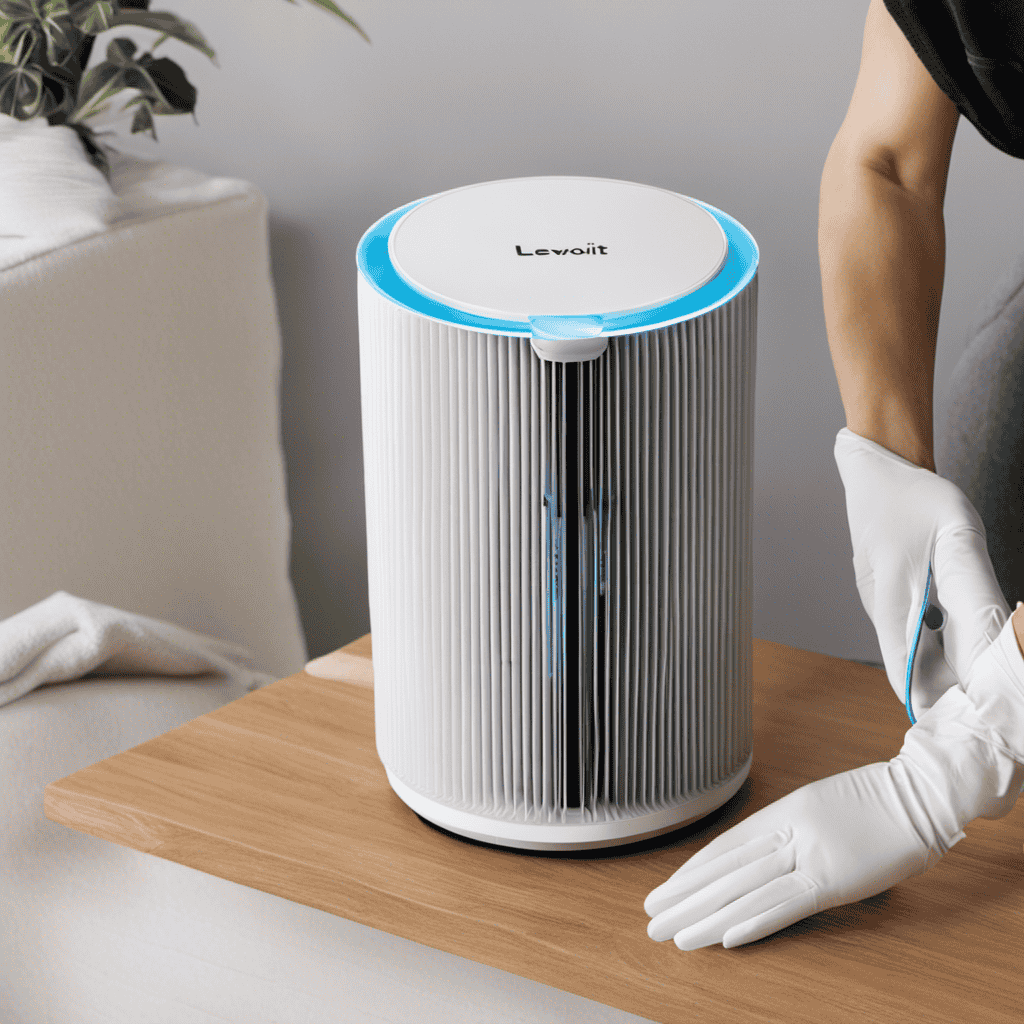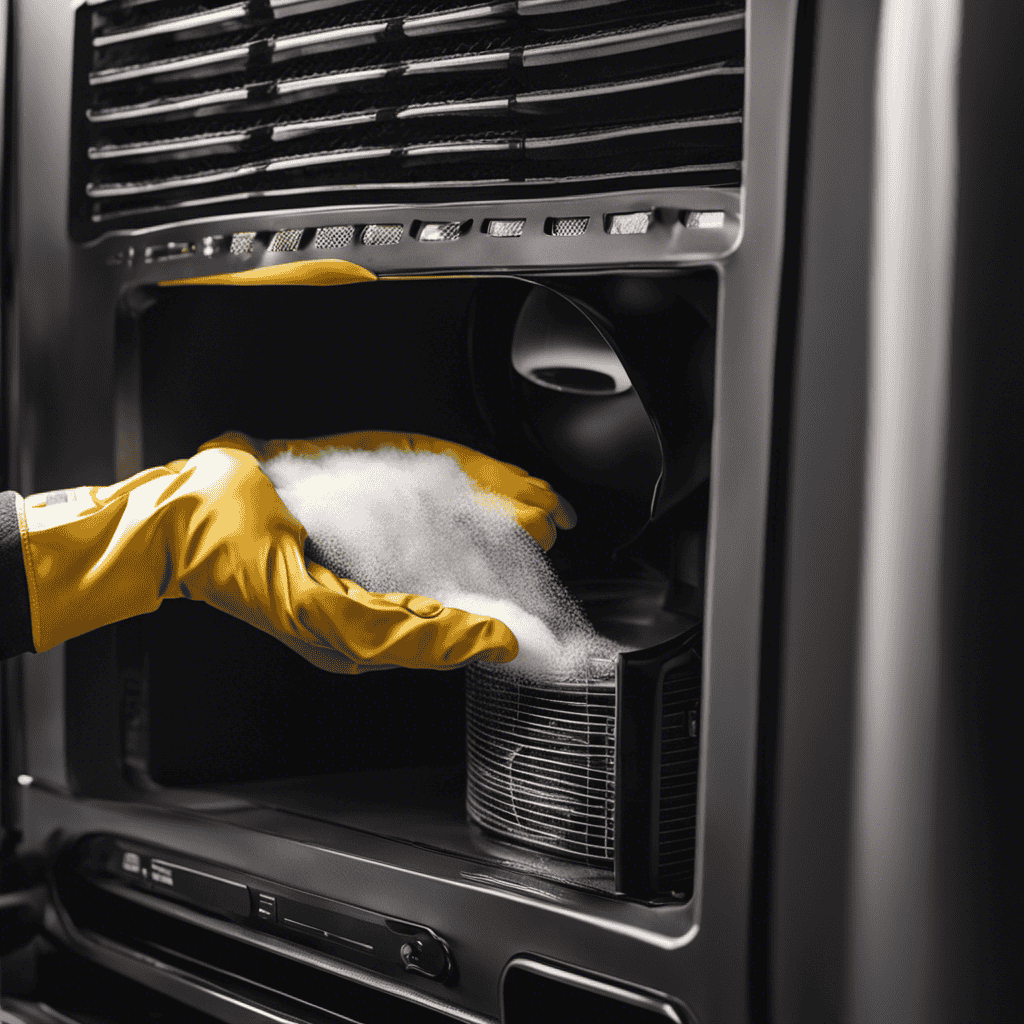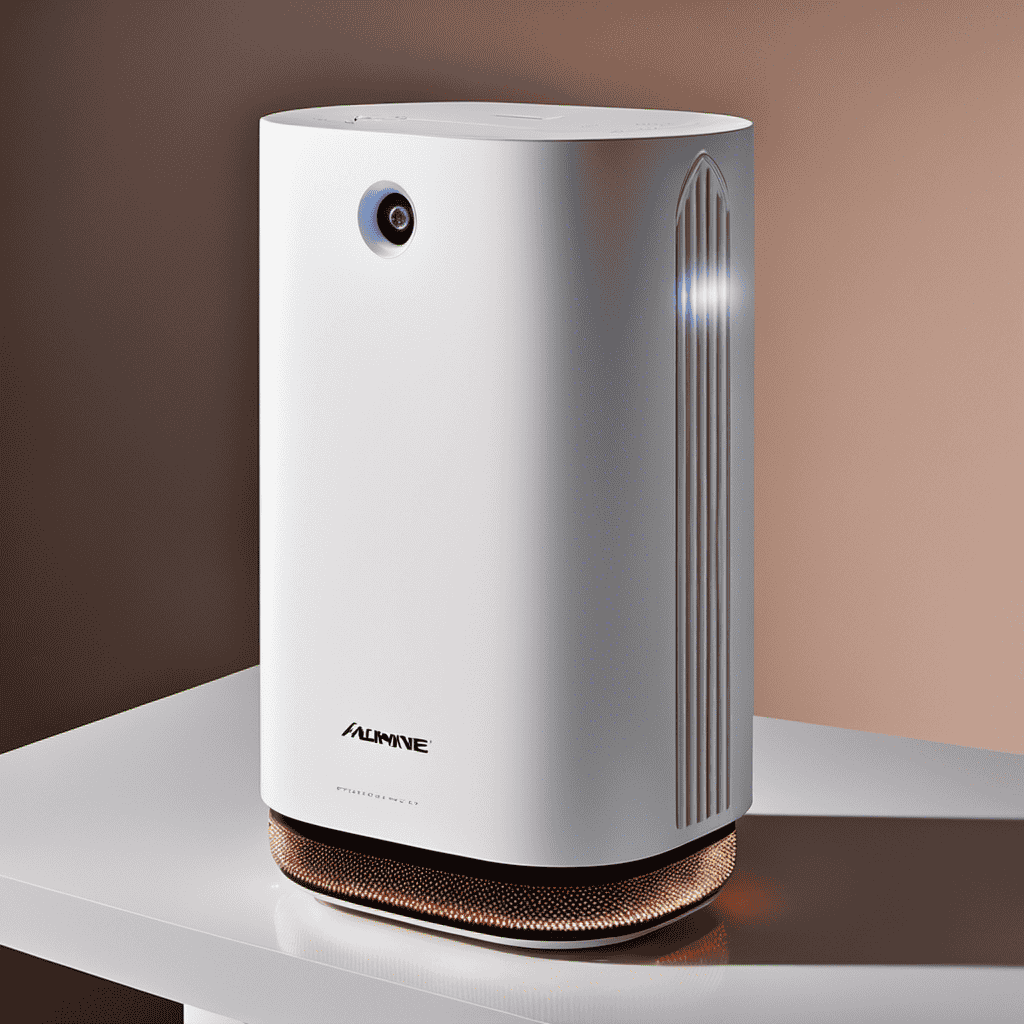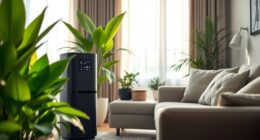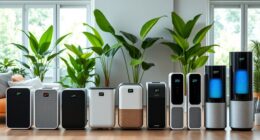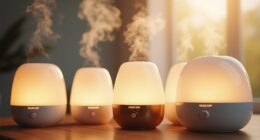I am here to demonstrate how you can properly clean your Levoit Air Purifier in order to ensure it continues to operate efficiently.
Think of your air purifier as a trusty companion, tirelessly working to keep the air in your home clean and fresh. But like any hardworking friend, it needs regular maintenance to stay in top shape.
In this article, I’ll guide you through the step-by-step process of cleaning your Levoit Air Purifier, from the pre-filter to the activated carbon filter.
Let’s get started!
Key Takeaways
- Regular cleaning of the Levoit Air Purifier is important to maintain efficiency and prolong its lifespan.
- Cleaning the filters, exterior, vents, control panel, and display is necessary for optimal performance and improved air quality.
- Proper cleaning supplies and equipment such as microfiber cloths, soft brush, vacuum cleaner with brush attachment, and compressed air canister are needed.
- Following the manufacturer’s instructions for filter replacement and cleaning frequency is essential for effective cleaning and troubleshooting common issues.
Why Clean Your Levoit Air Purifier Regularly
You should clean your Levoit air purifier regularly because it helps to maintain its efficiency and prolong its lifespan.
Cleaning your air purifier has several benefits, both in terms of cleaning and health. Regular cleaning ensures that the filters in your air purifier are free from dust, allergens, and other particles that can accumulate over time. By removing these contaminants, your air purifier can continue to effectively purify the air in your home.
Not only does this help to maintain clean and fresh air, but it also contributes to better indoor air quality, which has numerous health benefits. Clean air can reduce the symptoms of allergies, asthma, and other respiratory conditions, allowing you to breathe easier and improve your overall well-being.
Therefore, it is essential to clean your Levoit air purifier regularly to enjoy these cleaning and health benefits.
Understanding the Cleaning Instructions for Your Levoit Air Purifier
Proper maintenance techniques and cleaning frequency guidelines are crucial to ensure the optimal performance and longevity of your Levoit Air Purifier.
Regular maintenance will help keep your air purifier running efficiently and effectively, removing pollutants and allergens from your indoor air.
Proper Maintenance Techniques
To keep your Levoit air purifier running smoothly, make sure to regularly clean and replace the filters. Here are some cleaning techniques and maintenance tips that will help you maintain the optimal performance of your air purifier:
-
Vacuum the exterior: Use a soft brush attachment to gently vacuum the exterior of the air purifier to remove any dust or debris that may have accumulated.
-
Clean the pre-filter: The pre-filter is the first line of defense against larger particles. Remove it and rinse it under running water to remove any dust or dirt. Let it air dry before reinserting it.
-
Replace the filters: Depending on the model, your Levoit air purifier may have different types of filters such as HEPA, activated carbon, or ionizer filters. Follow the manufacturer’s instructions on when and how to replace these filters.
-
Check the air quality indicator: Some Levoit air purifiers come with an air quality indicator. Regularly check this indicator and follow the guidelines provided to ensure that your air purifier is working efficiently.
Cleaning Frequency Guidelines
For optimal performance, it’s important to regularly check the manufacturer’s guidelines for cleaning frequency. The cleaning schedule for a Levoit air purifier may vary depending on the model and usage.
Generally, it is recommended to clean the air purifier every 2-3 weeks. To clean the unit, start by unplugging it from the power source. Remove the front panel and gently wipe it with a soft, damp cloth. Be careful not to use any harsh cleaning agents or immerse the panel in water.
Next, remove the filter and gently vacuum it or rinse it under running water. Allow the filter to dry completely before reassembling the unit.
Following these cleaning techniques and adhering to the recommended cleaning schedule will help maintain the efficiency and prolong the lifespan of your Levoit air purifier.
Gathering the Necessary Cleaning Supplies for Your Levoit Air Purifier
When it comes to cleaning my Levoit Air Purifier, there are a few key points I need to keep in mind.
First and foremost, I must gather all the essential cleaning supplies, which include microfiber cloths, a soft brush, and a mild detergent.
Additionally, having the proper cleaning equipment, such as a vacuum cleaner with a brush attachment and a can of compressed air, is crucial for effectively removing dust and debris from the purifier’s surface and filters.
Lastly, using the necessary cleaning products, like a non-abrasive cleaner and a disinfectant spray, ensures that the air purifier is not only clean but also free from bacteria and allergens.
Essential Cleaning Supplies
You’ll need a few essential cleaning supplies to effectively clean your Levoit air purifier. Here are the items you will need:
-
Microfiber cloth: This soft cloth is perfect for wiping down the exterior of your air purifier. It won’t scratch the surface and will effectively remove any dust or dirt.
-
Cleaning solution: A mild, non-abrasive cleaning solution is recommended for cleaning the exterior and interior parts of your air purifier. Avoid using harsh chemicals that could damage the device.
-
Compressed air canister: This is useful for cleaning the vents and filters of your air purifier. It will blow away any trapped dust or debris, ensuring optimal performance.
-
Vacuum cleaner: Use a vacuum cleaner with a brush attachment to remove any dust or pet hair from the pre-filter and other hard-to-reach areas.
Remember to follow the recommended cleaning schedule provided by Levoit to maintain the effectiveness of your air purifier.
Regular cleaning techniques will help prolong the lifespan of your device and ensure that it continues to provide you with clean, fresh air.
Proper Cleaning Equipment
Using the recommended cleaning supplies and equipment will help maintain the effectiveness of your device. When it comes to cleaning a Levoit air purifier, having the right tools is essential. Here are the recommended cleaning equipment and techniques to keep your air purifier in top shape.
| Equipment | Recommended Products |
|---|---|
| Soft cloth | Microfiber cloth |
| Brush | Soft-bristle brush |
| Vacuum cleaner | HEPA filter vacuum cleaner |
| Compressed air can | Non-flammable compressed air can |
To begin, use a microfiber cloth to gently wipe the exterior of the air purifier. Be sure to avoid using any harsh chemicals that could damage the device. Next, use a soft-bristle brush to remove dust and debris from the air vents and filters. For a deeper clean, use a HEPA filter vacuum cleaner to remove any embedded particles. Finally, use a non-flammable compressed air can to blow away any remaining dust from hard-to-reach areas.
Following these cleaning techniques and using the recommended products will ensure that your Levoit air purifier continues to provide clean and fresh air for years to come.
Necessary Cleaning Products
To properly maintain your device, it is necessary to have the recommended cleaning products on hand. Here are the essential cleaning products you’ll need to keep your Levoit air purifier in top condition:
-
Microfiber cloth: This soft cloth is perfect for wiping down the exterior of the air purifier, removing any dust or dirt.
-
Brush attachment: Use a brush attachment on your vacuum cleaner to gently remove dust from the air purifier’s vents and filters.
-
Mild detergent: A mild detergent mixed with warm water can be used to clean the washable filters. Make sure to rinse them thoroughly and allow them to dry completely before reinstalling.
-
Compressed air: Use compressed air to blow away any stubborn dust or debris that may have accumulated in hard-to-reach areas.
Remember to follow the manufacturer’s instructions when cleaning your Levoit air purifier. Regular cleaning will help maintain its efficiency and prolong its lifespan.
Step-by-Step Guide to Cleaning the Pre-Filter of Your Levoit Air Purifier
First, make sure you unplug the Levoit air purifier before cleaning the pre-filter. Cleaning the pre-filter is an essential maintenance task that ensures your air purifier functions optimally. Here are some cleaning techniques and maintenance tips to help you keep your Levoit air purifier in top shape.
To clean the pre-filter, follow these simple steps:
- Remove the front panel of the air purifier by gently pulling it towards you.
- Take out the pre-filter from its housing and shake off any loose dirt or debris.
- Use a soft brush or vacuum cleaner with a brush attachment to remove stubborn dirt and dust.
- If necessary, rinse the pre-filter under running water to remove any remaining contaminants.
Make sure to let the pre-filter dry completely before reinserting it into the air purifier. Regularly cleaning the pre-filter will prolong its lifespan and maintain the efficiency of your Levoit air purifier.
How to Properly Clean the Activated Carbon Filter of Your Levoit Air Purifier
When cleaning the activated carbon filter, ensure that it is completely dry before inserting it back into the air purifier. Cleaning the activated carbon filter is an essential part of maintaining your Levoit Air Purifier. Here are some cleaning techniques and maintenance tips to help you keep your air purifier in optimal condition:
- Gently remove the activated carbon filter from the air purifier.
- Use a soft brush or vacuum cleaner to remove any dust or debris from the filter.
- Rinse the filter with water to remove any remaining particles.
- Allow the filter to air dry completely before reinserting it into the air purifier.
By following these cleaning techniques and maintenance tips, you can ensure that your Levoit Air Purifier continues to provide you with clean and fresh air.
Remember to clean the activated carbon filter regularly to maintain its efficiency in removing odors and harmful gases from your indoor environment.
Cleaning the True HEPA Filter of Your Levoit Air Purifier: Dos and Don’ts
When it comes to cleaning the True HEPA filter of my Levoit Air Purifier, I always make sure to follow proper cleaning techniques to ensure its effectiveness.
One important technique is to avoid damaging the filter during the cleaning process. By using gentle cleaning methods and avoiding harsh chemicals, I can maintain the filter’s efficiency and prolong its lifespan.
Proper Cleaning Techniques
To properly clean a Levoit air purifier, you should regularly wipe down the exterior with a soft cloth. This helps remove dust and dirt that can accumulate on the surface. However, cleaning the exterior is just one part of maintaining your air purifier.
Understanding filter types and choosing the right cleaning products are crucial steps in ensuring its optimal performance. Here are some tips to help you clean your air purifier effectively:
-
Turn off and unplug the air purifier before cleaning to avoid any electrical accidents.
-
Use a vacuum with a brush attachment to remove dust and debris from the air vents.
-
Clean the pre-filter by rinsing it with water or using a vacuum to remove larger particles.
-
For True HEPA filters, never wash or vacuum them as this can damage the delicate fibers.
Avoiding Damaging the Filter
Avoid washing or vacuuming True HEPA filters as it can harm the delicate fibers. Instead, follow these steps to clean your Levoit air purifier without damaging the filter.
First, turn off the unit and unplug it from the power source.
Next, remove the front panel to access the filter.
Gently tap the filter to remove any loose particles. Do not use water or any cleaning solutions on the filter.
To avoid clogging the filter, it is recommended to replace it every 6 to 12 months, depending on usage.
Regularly check for mold growth by inspecting the filter for any visible signs. If mold is present, it is crucial to replace the filter immediately to prevent further contamination.
Removing and Cleaning the Air Quality Sensor of Your Levoit Air Purifier
First, make sure you unplug the Levoit air purifier before attempting to remove and clean the air quality sensor. Cleaning the sensor is crucial for optimal performance and accurate air quality readings.
Here are some cleaning techniques and troubleshooting tips to help you maintain your air purifier:
- Gently remove the sensor cover by sliding it off or unscrewing it, depending on your model.
- Use a soft cloth or cotton swab dampened with mild soapy water to carefully wipe the sensor. Avoid using harsh chemicals or abrasive materials that could damage the sensor.
- Dry the sensor thoroughly before reattaching the cover.
- If the sensor still shows inaccurate readings after cleaning, try resetting the air purifier by holding down the power button for 5 seconds.
Regular cleaning of the air quality sensor will ensure your Levoit air purifier continues to provide clean and healthy air for your home.
Cleaning the Exterior of Your Levoit Air Purifier: Tips and Tricks
Make sure you regularly wipe down the exterior of your Levoit air purifier to keep it looking clean and dust-free. Cleaning the exterior of your air purifier is an essential part of maintenance to ensure its optimal performance and longevity.
To begin, unplug the unit from the power source and remove any filters or panels that may obstruct access to the exterior. Use a soft, lint-free cloth dampened with a mild household cleaner to gently wipe the surface of the air purifier, being careful not to saturate any openings or buttons.
For stubborn stains, you can make a paste using baking soda and water, apply it to the affected area, and gently scrub with a soft brush. Finally, wipe away any residue with a clean, damp cloth and allow the unit to air dry completely before reassembling.
Maintaining the Air Intake and Outlet Vents of Your Levoit Air Purifier
In my previous discussion, I covered some helpful tips and tricks for cleaning the exterior of your Levoit Air Purifier. Now, let’s shift our focus to maintaining the air intake and outlet vents of the purifier.
Understanding filter efficiency and the benefits of regular cleaning is crucial for optimal performance. Here are some key points to consider:
-
Check the air intake vents regularly: Dust and debris can accumulate on these vents, hindering air flow and reducing the purifier’s efficiency. Use a soft brush or vacuum cleaner attachment to gently remove any buildup.
-
Clean the outlet vents: Over time, the outlet vents can become clogged with dust particles. Wipe them down using a soft cloth or brush to ensure unrestricted airflow.
-
Improve filter efficiency: By keeping the vents clean, you prevent the accumulation of dirt on the filters. This enables them to work more effectively in capturing pollutants, extending their lifespan.
-
Enjoy the benefits of regular cleaning: Maintaining clean vents promotes better air circulation and ensures the purifier can effectively remove contaminants from your indoor environment. This leads to improved air quality and a healthier living space.
Cleaning the Control Panel and Display of Your Levoit Air Purifier
Regularly checking and wiping down the control panel and display helps to ensure smooth operation and easy visibility on your Levoit Air Purifier. To clean the control panel and display, first unplug the unit and remove any filters. Use a soft, lint-free cloth slightly dampened with water or a mild, non-abrasive cleaner to gently wipe the surface. Be careful not to let any liquid seep into the control panel or display.
For stubborn stains, you can use a mixture of water and mild dish soap. Avoid using harsh chemicals or abrasive materials as they can damage the surface. After cleaning, make sure the control panel and display are completely dry before reassembling the unit.
Additionally, don’t forget to clean the fan blades regularly to maintain optimal airflow.
How Often Should You Clean Your Levoit Air Purifier
Now that we know how to clean the control panel and display of our Levoit Air Purifier, let’s discuss how often we should clean it. Cleaning frequency guidelines are important to ensure optimal performance and longevity of your air purifier. Here are the benefits of regular cleaning:
- Improved air quality: Regular cleaning removes dust, allergens, and other particles from the filters, allowing the air purifier to effectively capture pollutants and provide cleaner air.
- Enhanced efficiency: Clean filters and components allow the air purifier to work more efficiently, reducing energy consumption.
- Prolonged lifespan: Regular cleaning prevents the buildup of dirt and debris, which can cause damage to the internal components and decrease the lifespan of the air purifier.
- Cost savings: By maintaining your air purifier regularly, you can avoid costly repairs or the need to replace it prematurely.
Now that we understand the importance of regular cleaning, let’s move on to the next section about tips for extending the lifespan of your Levoit Air Purifier.
Tips for Extending the Lifespan of Your Levoit Air Purifier
When it comes to maintaining and extending the lifespan of your Levoit Air Purifier, there are a few important dos and don’ts to keep in mind.
Firstly, it is crucial to follow the manufacturer’s guidelines for maintenance, which may include regular cleaning and filter replacement.
Secondly, avoid using harsh chemicals or abrasive materials when cleaning the unit, as this can damage the components.
Lastly, be sure to replace the filters at the recommended intervals, as this will ensure the air purifier continues to effectively remove pollutants from your indoor environment.
Maintenance Dos and Don’ts
To keep your Levoit air purifier running smoothly, remember not to neglect regular maintenance tasks. Here are some maintenance dos and don’ts to ensure your air purifier operates efficiently and effectively:
-
Do clean the pre-filter regularly: The pre-filter is the first line of defense against larger particles. Clean it every 2-3 weeks by vacuuming or rinsing it with water.
-
Don’t forget to clean the HEPA filter: The HEPA filter captures smaller particles and needs cleaning every 6-12 months. Remove it from the purifier and gently vacuum or rinse it to maintain its effectiveness.
-
Do wipe down the exterior regularly: Dust and dirt can accumulate on the surface of the purifier, hindering its performance. Use a soft cloth or sponge dampened with mild soap and water to clean the exterior.
-
Don’t neglect the air vents: The air vents can become clogged with dust, reducing airflow. Use a small brush or vacuum attachment to remove any debris from the vents.
Effective Filter Replacement
Regularly replacing the filters is essential for maintaining the effectiveness and efficiency of your air purifier.
To ensure optimal performance, here are some filter maintenance tips to follow.
Firstly, it’s crucial to check the manufacturer’s instructions for the recommended filter replacement schedule. Typically, filters should be replaced every 6 to 12 months, depending on usage and air quality.
Additionally, make sure to clean or replace pre-filters regularly to prevent dirt and debris from clogging the main filter. Regularly vacuuming the pre-filter can help extend the lifespan of the main filter.
It’s important to note that regular filter replacement is vital for maintaining clean and healthy air in your home. Neglecting to replace filters can lead to reduced air purifier performance and increased indoor air pollution.
Troubleshooting Common Cleaning Issues With Your Levoit Air Purifier
If you’re experiencing any issues while cleaning your Levoit air purifier, here are some troubleshooting tips to help you out:
-
Filter not fitting properly: Ensure that the filter is correctly aligned and securely placed in the unit. If it still doesn’t fit, check if you have the right filter model for your specific purifier.
-
Fan not working: Check if the power cord is securely plugged in. If it is, try resetting the power by unplugging the unit for a few minutes, then plugging it back in.
-
Strange odors: Clean the pre-filter and activated carbon filter regularly to eliminate any accumulated dust or odors. If the issue persists, consider replacing the filters.
-
Reduced airflow: Clean the air intake vents and the fan blades using a soft brush or vacuum cleaner to remove any dust or debris that may be obstructing the airflow.
Troubleshooting common issues with your Levoit air purifier will ensure its optimal performance and longevity.
Now, let’s move on to cleaning and disinfecting your Levoit air purifier after illness or contamination.
Cleaning and Disinfecting Your Levoit Air Purifier After Illness or Contamination
After an illness or contamination, it’s important to thoroughly sanitize and disinfect your Levoit air purifier to maintain a healthy and clean environment. Cleaning techniques and disinfecting methods are crucial in ensuring that your air purifier is free from any harmful bacteria or viruses. Here are some steps to follow when cleaning and disinfecting your Levoit air purifier:
| Cleaning Techniques | Disinfecting Methods |
|---|---|
| Use a soft cloth or brush to remove dust and debris from the exterior of the air purifier. | Mix a solution of warm water and mild detergent. Dip a cloth into the solution and gently wipe down the exterior and interior surfaces of the air purifier. |
| Remove the filter and wash it with water and mild detergent. Allow it to air dry before reinstalling. | Spray a disinfectant solution on a cloth and wipe down the exterior surfaces of the air purifier. Pay close attention to areas that come into contact with air pollutants. |
| Clean the air inlet and outlet vents with a brush to remove any dust or debris. | Allow the air purifier to dry completely before plugging it back in and turning it on. |
Proper Storage and Maintenance of Your Levoit Air Purifier
To keep your Levoit air purifier in optimal condition, it’s important to properly store and maintain it. Here are some storage tips and proper maintenance procedures to ensure the longevity and efficiency of your air purifier:
-
Clean the filters regularly: Dust and debris can accumulate on the filters, reducing their effectiveness. Clean them according to the manufacturer’s instructions or replace them if necessary.
-
Store in a cool, dry place: Avoid exposing your air purifier to extreme temperatures or humidity, as it can damage the internal components.
-
Keep the unit covered: When not in use, cover your air purifier with a dust cover or a clean cloth to protect it from dust and dirt.
-
Check for any signs of damage: Regularly inspect the air purifier for any signs of wear or damage. If you notice any issues, contact the manufacturer for assistance.
Frequently Asked Questions
Can I Use Any Type of Cleaning Solution on My Levoit Air Purifier?
Yes, you can use cleaning solutions on your Levoit Air Purifier. However, it is important to use only recommended products to avoid damaging the unit. Follow the manufacturer’s instructions for proper cleaning procedures.
How Often Should I Clean the Air Quality Sensor of My Levoit Air Purifier?
Cleaning the air quality sensor of my Levoit Air Purifier is an integral part of its maintenance. Regular cleaning ensures accurate readings and optimal performance. Let me share some tips on cleaning frequency and maintenance to keep your purifier in top shape.
Can I Clean the Exterior of My Levoit Air Purifier With Water?
Yes, you can clean the exterior of your Levoit air purifier with water. However, it is important to avoid getting water into the internal components. Follow the cleaning tips to prevent common cleaning mistakes.
How Do I Clean and Disinfect My Levoit Air Purifier After Illness or Contamination?
To clean and disinfect my Levoit Air Purifier after illness or contamination, I use proper cleaning techniques and disinfection methods. It’s important to follow the manufacturer’s instructions and regularly clean the filters for optimal performance.
What Is the Best Way to Store and Maintain My Levoit Air Purifier When Not in Use?
When not in use, I store my Levoit air purifier in a clean, dry place away from direct sunlight. Regular maintenance includes cleaning the filter every 3 months and wiping down the exterior with a damp cloth.
Can Cleaning the Levoit Air Purifier Affect Its Usage?
Yes, cleaning the Levoit Air Purifier can affect its usage. Regular maintenance, such as cleaning the filter and exterior, is essential for optimal performance when using Levoit Air Purifier. Neglecting to clean the unit can lead to decreased efficiency and effectiveness in purifying the air.
Conclusion
In conclusion, regularly cleaning your Levoit Air Purifier is crucial for maintaining its effectiveness and prolonging its lifespan. By following the cleaning instructions and using the necessary supplies, you can ensure that your air purifier is free from dust, allergens, and contaminants.
Did you know that a dirty air purifier can reduce its efficiency by up to 50%? Imagine the difference in air quality when your purifier is clean and operating at its full capacity.
So, make sure to clean your Levoit Air Purifier regularly to enjoy fresh and clean air in your home.
